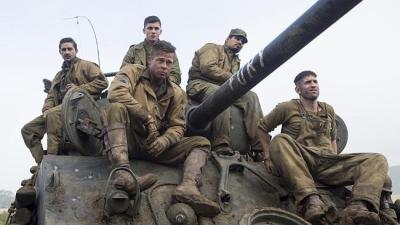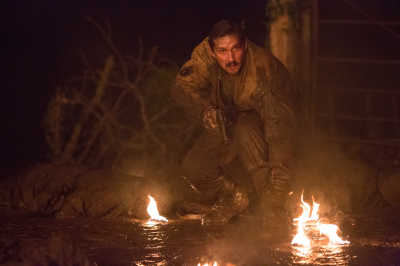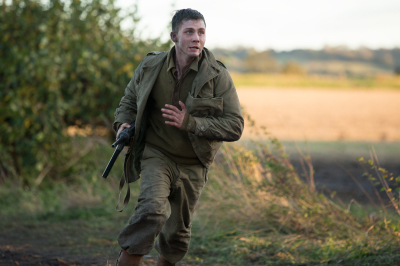Fury ratchets up the intensity from the opening moments and maintains it for over two hours through the introduction of characters that initially feel stock but become something else – and escalating violence and hints at the erosion of decency that war can cause.
We meet the crew of the M4 Sherman tank Fury (the named is roughly painted on the barrel of its big gun) as they return from a mission – during which they lost their assistant driver. To the dismay of everyone concerned, their replacement is a green kid, fresh from eight weeks of training – as a clerk-typist –Norman Ellison (Logan Lerman).
Tank commander Sgt. Don ‘Wardaddy’ Collier immediately begins the kid’s education to the facts of life WWII-style by forcing him to kill a German SS officer as they are en route to their next assignment – after he’s had to settle in by cleaning the remains of his predecessor from his seat! He wasn’t trained for this, declaring, ‘I was trained to type sixty words a minute!’
He is not going to enjoy the fury’s next assignment – holding a crossroads deep into enemy territory. Especially not with the fury’s crew being together since Africa. That crew is the kind of cross-section you expect in a war movie: Shia LaBeouf is Boyd ‘Bible’ Swan, the quietly religious one; Michael Pena is Trini ‘Gordo’ Garcia, the quietly fierce Hispanic, and Jon Bernthal is Grady ‘Coon-Ass’ Travis, the loud, vicious hillbilly. Each is formidable in some way and all are fiercely loyal to Wardaddy, who has promised to see them safely through the war – but that is getting harder and harder.
As Wardaddy tells Norman, ‘I killed Germans in Africa; I killed German in France, and now I’m killing Germans in Germany.’ When a harried officer (Jason Isaacs) wishes the Germans would just quit, Wardaddy’s response is, ‘Would you?”
Norman’s learning curve escalates as his decision not to shoot a barely seen figure in some trees leads to his column taking fire and, much as he hates having to do so, he quickly developes his ShootingAuthority and becomes an engine of destruction himself.
After the Allies take a German town, we get a moment of quasi-civilization as Wardaddy and Norman find a couple of woman hiding in a not-yet-destroyed apartment. They get a brief respite from the war, though that is destroyed when the rest of the crew find them and things go awry – just before an explosion of violence as German try to retake the town.
Once the smoke has settled, Wardaddy gets his new orders – along with a complement of men and three other tanks, they are to get to and hold a key crossroad. By the time they get there, they are alone and Fury has hit a mine, breaking a tread. And then there’s the battalion of SS troops – two or three hundred strong – that are advancing on their position and are definitely not looking to surrender.
Written and directed by David Ayer (Training Day, End of Watch), fury is a classic WWII movie in terms of the events it relates. Where it adds to the genre is in the subtle shadings of some of the characters juxtaposed with violent shifts in others.
There moments when we see that Wardaddy was clearly a decent man before he found himself in a war – his gentlemanly side and the contrasting behavior of some of his crew in that German apartment is only one glimpse of that. A later moment where Coon-Ass steps way out of what we perceive his character to be works because Bernthal has both the range and the charisma to pull it off – and it acts as a kind of mirror image of Norman’s progression.
While the cast is pretty spectacular, Fury is Logan Lerman’s movie. His portrayal of Norman – his first major adult role – is senses-staggering. He was terrific in The Perks of Being a Wallflower, but he stretches in all kinds of ways in Fury. Odds are good that he won’t figure in awards conversations, but he really should.
Writer/director Ayer not only gets fine performances from his cast – Pitt once again shows that he has serious chops; LaBeouf hasn’t been this good in a very long time – but develops the combat sequences in ways that, if not entirely new, are striking. He juxtaposes the most insanely dark violence with elegant, graceful camera moves – the contrast between what goes on in the frame and the way the frame is constructed combine to achieve a power that is rare for a war movie.
In fact, to label Fury ‘just another war movie’ would be a huge mistake. If the best war movies show us that the horrors made by people are deeper and more relentless than anything actual horror movies can create, then Fury is one of the best.
In relative terms, that is so good that even though technical difficulties caused the screening to start a full half hour late, and the audience was extremely restless when it finally began, no one was grumbling when the credits rolled. Fury held that once-restive audience on the edge of their seats throughout. That’s impressive.
In personal terms, I had a third of my giant economy-sized diet cola left when the credits rolled almost three hours after I took my seat.
Final Grade: A+
Photos by Giles Keyte/Courtesy of Columbia Pictures


